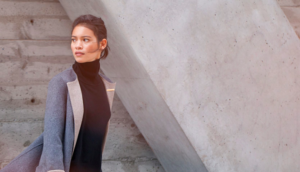So what does fashion do for women?
This summer, I’ll be rolling out a series on fashion and intersectional feminism, which I firmly believe can (and must) be allies.
According to a study put out by the Clean Clothes Campaign in 2015, between 60 and 75 million people work in the global garment industry. Women make up three fourths of the workforce. In Bangladesh alone, 3.5 million people- 2.98 million women- have a job in garment work. 2.98 million Bangladeshi women rely on the global fashion industry to support themselves, for better or for worse. What if it could be for better?
Fashion also has the potential to empower through art. Isn’t that why we all fell in love with it in the first place? I still remember the way I felt in my first vintage dress, as if I had inherited decades of confidence from the floaty orange fabric. I felt authentically represented in it, felt powerful. All women deserve to wear what makes them comfortable, proud, and honest. They deserve companies that reflect them through the entire process. From advertising to sizing, the consumer end of fashion can reinforce or challenge established norms. That’s a great opportunity. Through employment, advancement, representation, and more, I know fashion can transform itself into an ally of all women, all over the globe.
After relying on them to support the industry for decades, it’s time for fashion to start supporting gals.
As I began pondering this lofty goal, I noticed an exciting trend. I was becoming aware of amazing charities, each addressing different needs in groups of marginalized women, because local women-owned brands were raising money and awareness for them. When it comes to bringing about an awareness about necessary issues in our society, there are a number of worthy community fundraising ideas to explore, too. It’s often a percentage of sales, which is great! That’s what I typically expect from giveback programs. Then I met Quinn.[/vc_column_text][vc_single_image image=”3494″ img_size=”large” add_caption=”yes” alignment=”center” onclick=”custom_link” img_link_target=”_blank” link=”https://remnantstudios.org/pages/about-remnant-studios”][vc_column_text]Quinn Smith, the brain (and heart!) behind Remnant Studios, was one of the first women I met in Austin’s conscious fashion community. It was during the East Side Studio Tour, and my friend and I were first struck by how gorgeous her pieces were. We oohed and ahhed over delicate porcelain studs dipped in gold, swirled with blue, each piece both delicate and playful. It was only after ogling that we noticed the canvas banner behind her: Non-profit company. A non-profit retailer??
Yes, after the cost of materials, all of Remnant Studios’ profits go to three NGO’s fighting sex trafficking. She supports The A21 Campaign, The Refuge DMST, and Global Child Advocates. At the end of 2017, Quinn’s ceramic jewelry had raised $44,000 for these organizations. $44,000!!! It’s like the lemonade sale you held as a child to raise money for charity, only better. Way, way better.
I had to learn more, so I chatted with Quinn, and she filled me in on her designs, her goals, and her fierce fight against trafficking.[/vc_column_text][vc_separator][vc_column_text]
Tell me about your background in fashion!
I kind of stumbled into the fashion world by accident. I’ve never really followed fashion, but I’ve always pursued art in various forms. So when the opportunity came to start my business jewelry made the most sense. It allows me to combine creative freedom and raising the most money to fight human trafficking. But now that I’m contributing to fashion I have become aware of its impact (both good and bad) on humanity and the earth. Now I try to source and produce as ethically as possible.
What inspires your jewelry designs?
Nature and geometry inspire my jewelry. I am somewhat dual-brained. The complexities and beauty of nature inspire me, as well as the science and math behind it. Leaves will always be a staple in my line because they represent starting over and a new season – things without which we lose hope for a purposeful future. More recently I’ve been applying geometric patterns with gold and colors I really enjoy.
What materials do you use in your pieces?
Porcelain clay, leather, sterling silver and 14k gold-filled jewelry findings.[/vc_column_text][/vc_column][/vc_row][vc_row][vc_column width=”1/3″][vc_single_image image=”3497″ img_size=”medium” onclick=”custom_link” img_link_target=”_blank” link=”https://remnantstudios.org/collections/stud-earrings/products/black-and-white-striped-studs-1?variant=8049333043247″][/vc_column][vc_column width=”1/3″][vc_single_image image=”3498″ img_size=”medium” onclick=”custom_link” img_link_target=”_blank” link=”https://remnantstudios.org/collections/necklaces-1/products/porcelain-penant-banner-necklace-with-gold-accent”][/vc_column][vc_column width=”1/3″][vc_single_image image=”3499″ img_size=”medium” onclick=”custom_link” img_link_target=”_blank” link=”https://remnantstudios.org/collections/stud-earrings/products/teal-granite-studs-with-gold-accent-2″][/vc_column][/vc_row][vc_row][vc_column][vc_column_text]
How do you source them?
The porcelain comes from Laguna Clay in the US, leather comes from scraps sold by Tandy Leather, and jewelry findings are from Rio Grande Jewelry Supply. I detail these on my website: https://remnantstudios.org/pages/ethical-sourcing
Note from Scout: This is the kind of transparency I’d love to see more of! An excerpt from Quinn’s sourcing breakdown: “It feels yuck to think that your do-gooder business might actually be harming the world. As a social business owner, if I were using unethically sourced materials to create my jewelry, it would be at least ironic and at most devastating. While researching the companies I buy from I uncovered both ethical and unethical practices and have made adjustments accordingly.”
How did you first learn about trafficking, and what motivated you to become involved?
I helped a friend organize a walk in Austin by a non-profit called Stop Child Trafficking Now in 2012. It was then I learned what a pernicious and epidemic problem human trafficking/slavery was in the world. My dream was always to make art and sell it to raise money for a cause, and when I learned about human trafficking, I knew the fight against it would be the cause I would support.
What was the process of starting Remnant Studios?
I applied for an LLC and bought my first jewelry kiln in March of 2014. I started my first few rounds of jewelry that spring and summer and by September I had enough to launch an Etsy store. In the spring of this year I rebranded from Remnant Ceramics to Remnant Studios to leave space for other creative endeavors outside of ceramics. I haven’t pulled the trigger on anything new yet, but I’ve got ideas!
What’s next for Remnant Studios?
I’m challenged by balancing a family and this business, so I take every opportunity for growth as it comes. I’d love to get into more boutiques and explore other creative outlets. I’m also in the process of becoming a non-profit 501(c)(3), which will allow Remnant Studios to better appropriate profits.
Tell me a little about Sojourn Studios!
I had the amazing opportunity to teach an artisan group of teenage Burmese refugees on the Thai/Myanmar border how to make ceramic jewelry last year. They are Sojourn Studios and they make and sell their own jewelry now. The group exists within a larger NGO called Global Child Advocates that serves the refugee community on the border. Their ethos with Sojourn Studios is to instill hope and skills in girls that are otherwise vulnerable to poverty, trafficking and hopelessness.[/vc_column_text][vc_single_image image=”3501″ img_size=”large” add_caption=”yes” onclick=”custom_link” img_link_target=”_blank” link=”https://www.etsy.com/shop/SojournStudio?ref=l2-shopheader-name”][vc_column_text]
What are your thoughts about ethical fashion? Can it compete against fast and luxury fashion?
I’m so thankful for ethical fashion because it helps expose exploitation in the industry. It educates consumers who, in turn, advocate for those makers and companies engaging in ethical practices. I think the sooner ethical brands can meet the needs of consumers to spend wisely for good design, the more competitive they become. As a culture, we have to buy into the concept. We have to prove that the ethical treatment of other humans and our planet is a higher goal than scoring cheap clothes. We’re starting to move in that direction. Today, I’m hopeful that with more awareness, education, and accessibility, we can eventually get there.
What would you like to see more of in the ethical fashion world?
Clothing for kids! I shop for my three kids and they constantly grow and need new pieces. I do buy a lot of second hand clothing for them, but it can be hard to find specific things like shoes and sports clothes that are in good shape and ethically made.
Aside from purchasing your jewelry, what other steps can people take to aid the fight against trafficking?
Educating oneself about the issue and bringing awareness to family and friends are two first steps. I especially talk to teenagers in my life about the dangers for them in our country, where they are particularly targeted through social media. There are many ways to fight with our dollars. You can spend with companies like mine who donate profits to the fight. You can donate directly to organizations on the front lines, and finally, have friends and family donate in lieu of gifts on special occasions. Most of the responsibility should however fall upon those working in the industry. Many people know about the unethical practices of their employers but are too scared to come forward. Those who have information that can protect women from trafficking could always talk to a whistleblower attorney so that they can be confident when informing the public about what really goes on in their industry. Also, learning about the signs that someone is being trafficked and making a call on their behalf to 911 could save their life. The National Trafficking Hotline (1-888-373-7888) should be called if you suspect trafficking activity.[/vc_column_text][vc_separator][vc_column_text]
A silent struggle
Sex trafficking is a worldwide issue affecting women, girls, men, and boys; however, the burden lies disproportionately on women and girls. According to the National Human Trafficking Hotline, in 2017, 83% of reported cases of trafficking in the US involved women. This statistic is representative of all forms of trafficking. And it’s likely that the proportion of women victimized by sex trafficking is even more substantial. A 2015 report by the Polaris Project indicates that between 94% and 96% of all reported sex trafficking cases involved women and girls. Globally, the International Labor Organization estimates there are 4.5 million people trapped by sex trafficking.
Based on existing statistics, we can assume that means upwards of 4.1 million women and girls in the world are enslaved.
The issue is widespread and hard to pin down; the three NGO’s Quinn has chosen to support cover a variety of bases. The Refuge DMST is the most localized of the three. Based just outside of Austin, this organization rehabilitates girls through age 19 who have been rescued. They combine education, healthcare, and mental health services in a holistic program. Global Child Advocates, located in Thailand, focuses its efforts on the Thai/Burma border. This unique organization actively works to prevent trafficking in this at-risk area. Finally, The A21 campaign is a massive, worldwide force. They work hard to educate at-risk women and children, rescue victims, and rehabilitate survivors. (I encourage you to go on their site and watch their compelling video campaigns on the subtle signs of trafficking. We should all be on the lookout.)
My takeaway.
Yes, this violence against women (and all people) is scary and silent and sobering. But people like Quinn are taking action and making amazing strides. Supporting these organizations means more resources for education, outreach, prevention, detection, and rehabilitation. It means more women coming home, or never being taken in the first place.
And sometimes, when fashion is willing to fight for women, it can also mean a pair of earrings that get you a ton of compliments.
I’m so inspired by Quinn and her willingness to pay her talent forward. While not everyone has the ability to donate all of the profits from their job or side hustle, Remnant Studios has me wondering how I can create long-term giving structures in my own life.
Do you guys have any thoughts?[/vc_column_text][/vc_column][/vc_row][vc_row][vc_column][vc_column_text]
P.s. Other ethical writers we love have also done their research on non-profits worth your dollar.
Alden Wicker of EcoCult penned a thought provoking piece on why environmentalists should be supporting family-planning organizations.
Renee Peters of Model4greenliving has a list of the best environmental nonprofits to give to.
Jessica of All There August donates to Alley Cat Allies, “The Global Engine Of Change For Cats”
Jen of Honestly Modern thinks we should think beyond personal consumption habits and donate to nonprofits that address waste on a large scale.[/vc_column_text][vc_column_text]
References
To read more about the National Human Trafficking Hotline and check their harrowing statistics, click here.
Click here to look at the 2015 report by Polaris Project I reference.[/vc_column_text][/vc_column][/vc_row]




